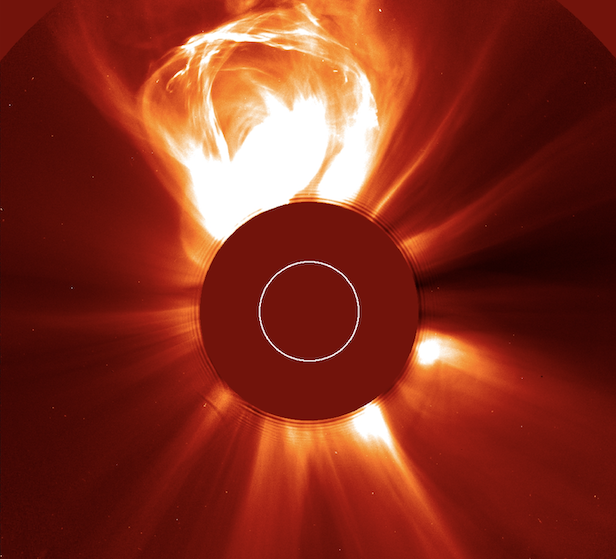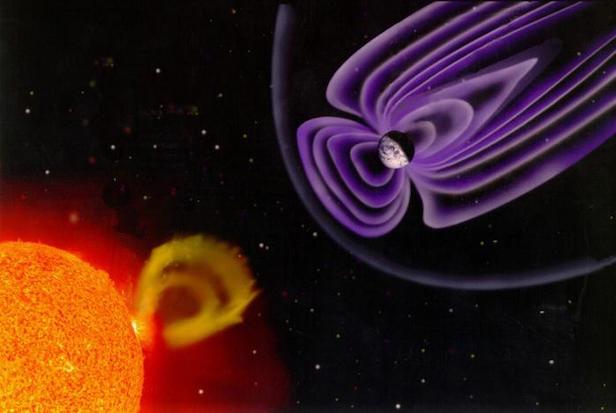NASA must pick one of two missions to study the space around Sun
These two mission concepts would study the Sun’s influence on interplanetary study using SmallSat technologies

NASA has selected two proposals to demonstrate technologies to improve science observations in deep space. The proposals could help NASA develop better models to predict space weather events that can affect astronauts and spacecraft, such as coronal mass ejections (CMEs). Image credit: ESA/NASA/SOHO
NASA has selected two proposals to demonstrate small satellite technologies to improve science observations in deep space, which could help NASA develop better models to predict space weather events that can affect astronauts and spacecraft.
“This is the first time that our heliophysics program has funded this kind of technology demonstration,” says Peg Luce, deputy director of the Heliophysics Division at NASA Headquarters. “Providing the opportunity to mature and test technologies in deep space is a crucial step towards incorporating new techniques into future missions.”
Both proposals, funded at £330,000 ($400,000) for nine-month mission concept studies, were selected based on potential technology and science value and the feasibility of development plans. They support NASA’s heliophysics program, which seeks to better understand the nature of space throughout the Solar System and how it changes in response to the constant outpouring of energy and particles from the Sun and how it interacts with planetary atmospheres.
At the conclusion of the nine-month study period, one proposal will be selected to launch as a secondary payload with NASA’s Interstellar Mapping and Acceleration Probe (IMAP) spacecraft in October 2024. Taking advantage of NASA’s cost-saving rideshare initiative, it will be accompanied by two other science missions – a NASA science mission of opportunity and a National Oceanic and Atmospheric Administration (NOAA) space weather forecasting mission.
“By focusing on SmallSats and capitalising on the cost savings of sharing a launch, we can test and advance cutting-edge technologies at a reasonable price,” says Thomas Zurbuchen, associate administrator for NASA’s Science Mission Directorate. “We are leading the charge in using this innovative solution to test new mission paradigms and technologies and, in turn, to reap great rewards researching our neighbourhood in space.” The proposals for the technology demonstrations are:

The source of space weather, our dynamic Sun, shown with a coronal mass ejection that will interact with the terrestrial magnetosphere producing geospace storms. Image credit: NASA
Science-Enabling Technologies for Heliophysics (SETH)
SETH would demonstrate two technologies. The first is an optical communications technology for small satellites and CubeSats that is less complex than current systems and could enable a hundredfold increase in deep space data rates, while reducing the burden on NASA’s Deep Space Network. Such technology could help support future small satellite constellations that require high data rate communications systems.
The second technology demonstration aboard SETH detects solar energetic neutral atoms – fast-moving atoms flowing from the Sun that do not have a charge – as well as an array of waves and other particles that erupt from our Sun. Called the HELio Energetic Neutral Atom (HELENA) detector, the instrument provides observations that could enable advanced warnings of potential space radiation threats to astronauts.
The principal investigator for SETH is Antti Pulkkinen at NASA’s Goddard Space Flight Center in Greenbelt, Maryland, United States.
Solar Cruiser
The Solar Cruiser investigation also demonstrates two technologies. A nearly 1,700-square-metre (18,000-square-foot) solar sail would demonstrate the ability to use solar radiation as a propulsion system. Such a system could provide views of the Sun not easily accessible with current technology.
The coronagraph instrument would enable simultaneous measurements of the Sun’s magnetic field structure and velocity of coronal mass ejections, or CMEs. These giant explosions of solar material are ejected into space and can set off space weather storms that, at their worst, interfere with utility grids on Earth. Improving data-gathering technology in this area is particularly useful for advance warning systems for at-risk infrastructure on Earth.
The principal investigator for Solar Cruiser is Les Johnson at NASA’s Marshall Space Flight Center in Huntsville, Alabama, United States.
Keep up to date with the latest news in All About Space – available every month for just £4.99. Alternatively you can subscribe here for a fraction of the price!




